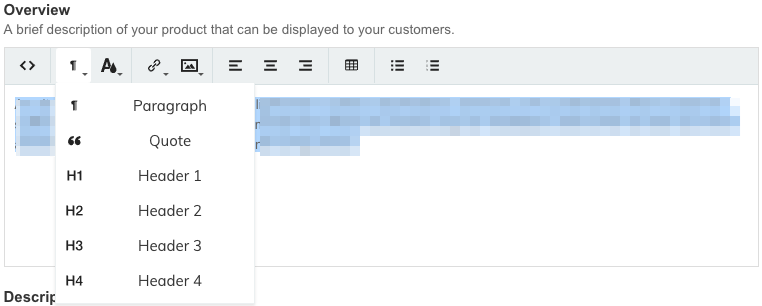SEO Best Practices Overview
Managing & Creating URL Rewrites
The URL Rewrite Management tool lets you change any URL that is associated with a product or category page. You can also import URL Rewrites using a CSV file.
Zoey creates automatically a URL rewrite anytime the URL for a product or category changes.
Setting Meta Data & Tags
Edit My Design | Page Settings for each individual page | Page Name and Description |
Products | Products > Product List (open each product) | Search Engine Preview > Edit SEO Title and Description |
Category | Products > Categories (each category) | Search Engine Preview > Edit SEO Title and Description |
Images | Design Center | If you open an image to edit it you will find the Alt Text to add labels relevant to SEO. |
Images | Product Page | Change the Image Label for your product images by clicking on the gear icon. |
Headings |
| The WYSIWYG Editor allows you to change the font from Paragraph to use Heading 1-4. |
If you open either your products and categories and work with the overview or description you can select the icon for "paragraph" and select from the dropdown the Header or Heading.
In Edit My Design you would click on a text block and select Edit Text to open the WYSIWYG Editor:

Make sure to highlight the text part you want to set to a Header 1-4.
Set which Attributes are Searchable
Product Attributes have the option to Use in Quick Search or Use in Advanced Search. Use your Meta Keywords to index popular misspellings of the item? Turn on "Use in Quick Search" to allow customers to find the item in your store without adding that misspelling to your description.
The stronger your store’s searching capabilities, the less time shoppers will take to find the products they want, and the better the chances will be that these shoppers will be converted into customers.
Setting Up Google Analytics and Webmaster Tools
Get detailed statistics about your website visitors by enabling Google Analytics on your store.
With Google Webmaster Tools you can submit a sitemap or get diagnose your site.
Setting Up a Sitemap
A sitemap is like a table of contents that lists every category and product in your store. Each entry is linked to the corresponding landing page of the category or product. Sitemaps help search engines index your site, and also gives visitors a quick overview of the organization of your store and catalog.
A Google sitemap is an index of all the pages in your site. However, unlike your store's built-in sitemap, a Google sitemap is specifically designed to be used as a roadmap when their search bot crawls your site.
Catalog URL Options
Although you might not give it much thought at the beginning, the URLs you assign to products and categories play a major role in determining how well your site is indexed by search engines. Before you start building your catalog is an ideal time to consider the available options.
Automatic Product Redirects
This comes already built in with each store and no need for you to worry about editing your product or category URL keys. If you want to redirect old URLs to new ones, use a CSV file to import your 301 redirects.
Canonical Meta Tag
Some search engines penalize websites for having multiple URLs with seemingly identical content. The canonical meta tag tells search engines which page to index when there are multiple URLs that have identical or very similar content. Using the canonical meta tag can improve your site ranking and aggregate page views.
NOTE: Zoey is already optimized and uses by default canonical meta tags - no need for further action!
Updated 7 months ago
